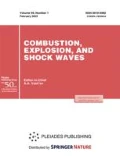Abstract
The existence of a new type of superadiabatic temperature phenomenon in flames and during autoignition due to a competition between chemical reactions is inferred from literature data and the results of mathematical modeling of chemical kinetics and numerical experiments. The mechanisms, conditions for the occurrence, and nature of the phenomenon are discussed. It is noted that this phenomenon may have promising academic and practical applications.
Similar content being viewed by others
References
V. S. Babkin, I. Wierzba, and C. A. Karim, “The Phenomenon of Energy Concentration on Combustion Waves and Applications,” Chem. Eng. J. 91, 279–285 (2003).
Propagation of Thermal Waves in Heterogeneous Media (Nauka, Novosibirsk, 1988) [in Russian].
A. I. Rozlovskii, “Thermal Regime of Combustion of Rich Carbon-Containing Mixtures of Subcritical Composition,” Dokl. Akad. Nauk SSSR 186(2), 373–376 (1969).
J. M. Singer and J. Grumer, “Carbon Formation in Very Rich Hydrocarbon-Air Flames-1. Studies of Chemical Content, Temperature, Ionization and Particulate Matter,” Proc. Combust. Inst. 7, 559–569 (1958).
E. Meeks, R. J. Kee, D. S. Dandy, and M. E. Coltrin, “Computational Simulation of Diamond Chemical Vapor CH4/O2-Strained Flames,” Combust. Flame 92, 144–160 (1993).
K. E. Bertagnolli and R. P. Lucht, “Temperature Profile Measurements in Stagnation-Flow Diamond-Forming Flames Using Hydrogen CARS Spectroscopy,” Proc. Combust. Inst. 26, 1825–1833 (1996).
B. Ruf, F. Behrendt, O. Deutschmann, S. Kleditzsch, and J. Warnatz, “Modeling of Chemical Vapor Deposition of Diamond Films from Acetylene-Oxygen Flames,” Proc. Combust. Inst. 28, 1455–1461 (2000).
F. Liu, H. Guo, G. J. Smallwood, and O. L. Gülder, “Numerical Study of the Superadiabatic Flame Temperature Phenomenon in Hydrocarbon Premixed Flames,” Proc. Combust. Inst. 29, 1543–1550 (2002).
V. V. Zamaschikov, I. G. Namyatov, V. A. Bunev, and V. S. Babkin, “On the Nature of Superadiabatic Temperatures in Premixed Rich Hydrocarbon Flames,” Fiz. Goreniya Vzryva 40(1), 38–41 (2004) [Combust., Expl., Shock Waves 40 (1), 32–35 (2004)]
F. Liu and O. L. Gülder, “Effects of H2 and H Preferential Diffusion and Unity Lewis Number on Superadiabatic Flame Temperatures in Rich Premixed Methane Flames,” Combust. Flame 143, 264–281 (2005).
E. Terres and F. Plenz, “Influence of Pressure on the Burning of Gas Mixtures,” J. Gasdbel. 57, 990–1027 (1914).
W. A. Bone, D. M. Newitt, and C. M. Smith, “Gaseous Combustion at High Pressures. IX. The Influence of Pressure Upon the “Explosion Limits” of Inflammable Gas-Air, etc., Mixtures,” Proc. Roy. Soc. A117, 553–576 (1928).
G. W. Jones, R. E. Kennedy, and J. Spolan, “Effect of High Pressures on the Flammability of Natural Gas-Air-Nitrogen Mixtures,” Bur. Mines Rep. Invest. 4557 (1949).
Ya. B. Zel’dovich, Theory of Combustion and Detonation of Gases (Izd. Akad. Nauk SSSR, Moscow-Leningrad, 1944) [in Russian].
K. K. Andreev and A. F. Belyaev, Theory of Explosives, (Moscow, Oborongiz, 1960) [in Russian].
K. K. Kuo, Principles of Combustion (John & Sons. Inc., 1986).
V. A. Bunev, T. A. Bol’shova, and V. S. Babkin, “On the Nature of the Upper Limit of Laminar Flame Propagation in Methane-Air Mixtures at High Pressures,” Dokl. Akad. Nauk 452(1), 52–54 (2013).
A. E. Lutz, R. J. Kee, J. F. Grear, et al., OPPDIF: A Fortran Program for Combus ting Opposed-Flow Diffusion Flames (Sandia National Laboratories, Livermore, California, 1996).
G. P. Smith, D. M. Golden, M. Frenklach, et al., http://www.Me.berkeley.edu/gri_mech.2000.
C. K. Low, D. L. Zhu, and G. Yu, “Propagation and Extinction of Stretched Premixed Flames,” Proc. Combust. Inst. 21, 1419–1426 (1986).
B. A. Albrecht, J. B. W. Kok, N. Dijkstra, and T. van der Meer, “Prediction and Measurement of the Product Gas Composition of the Ultra Rich Premixed Combustion of Natural Gas: Effects of Equivalence Ratio, Residence Time, Pressure, and Oxygen Concentration,” Combust. Sci. Technol. 181, 433–456 (2009).
V. A. Bunev and V. S. Babkin, “Chemical Reactions in the Low-Temperature Zone of a Laminar Rich Propane-Air Flame,” Fiz. Goreniya Vzryva 42(5), 14–19 (2006) [Combust., Expl., Shock Waves 42 (5), 503–598 (2006)].
V. A. Bunev, “Main Dangers in the Use of Dimethyl Ether as a Fuel,” Ekolog. Khim. 16, 107–123 (2007).
V. A. Bunev, V. S. Babkin, “Effect of Superadiabatic Temperatures in the Autoignition of Dimethyl Ether Mixtures,” Mendeleev Commun. 19, 290–291 (2009).
B. Lewis and G. von Elbe, “On the Theory of Flame Propagation,” J. Chem. Phys. 2, 537 (1934).
O. P. Korobeinichev, A. A. Paletsky, A. A. Bolshova, and V. D. Knyazev, “A Numerical Study of the Superadiabatic Flame Temperature Phenomenon in HN3 Flames,” Combust. Theory Modell. 16(5), 927–939 (2012).
J. J. Macfarlane, “Carbon Formation Premixed Methane-Oxygen Flames under Constant-Volume Combustion,” Combust. Flame 14, 67–72 (1970).
V. S. Babkin and A. V. V’yun, “Effect of Water Vapor on the Normal Velocity of a Methane-Air Mixture at High Pressures,” Fiz. Goreniya Vzryva 7(3), 392–395 (1971) [Combust., Expl., Shock Waves 7 (3), 339–341 (1971)].
Author information
Authors and Affiliations
Corresponding author
Additional information
Original Russian Text © V.S. Babkin, V.A. Bunev, T.A. Bolshova.
Published in Fizika Goreniya i Vzryva, Vol. 51, No. 2, pp. 14–22, March–April, 2015.
Rights and permissions
About this article
Cite this article
Babkin, V.S., Bunev, V.A. & Bolshova, T.A. Superadiabatic temperature phenomenon in the combustion processes due to a competition between chemical reactions. Combust Explos Shock Waves 51, 151–159 (2015). https://doi.org/10.1134/S0010508215020021
Received:
Published:
Issue Date:
DOI: https://doi.org/10.1134/S0010508215020021




